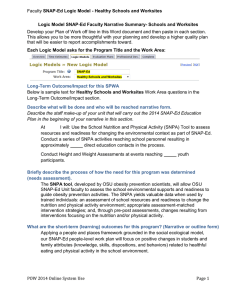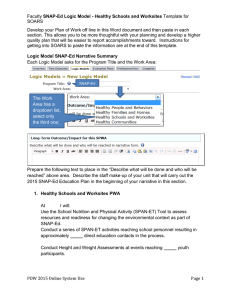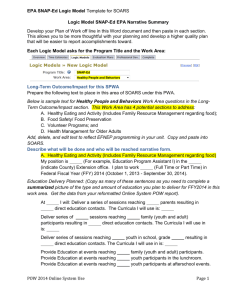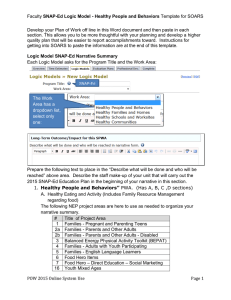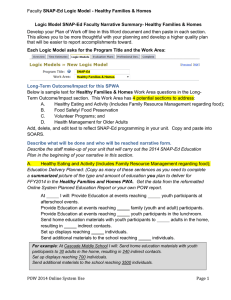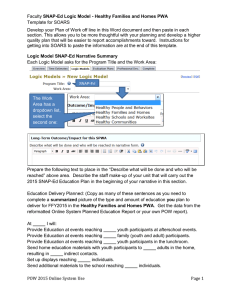Faculty SNAP-Ed Logic Model - Healthy People and Behaviors Template
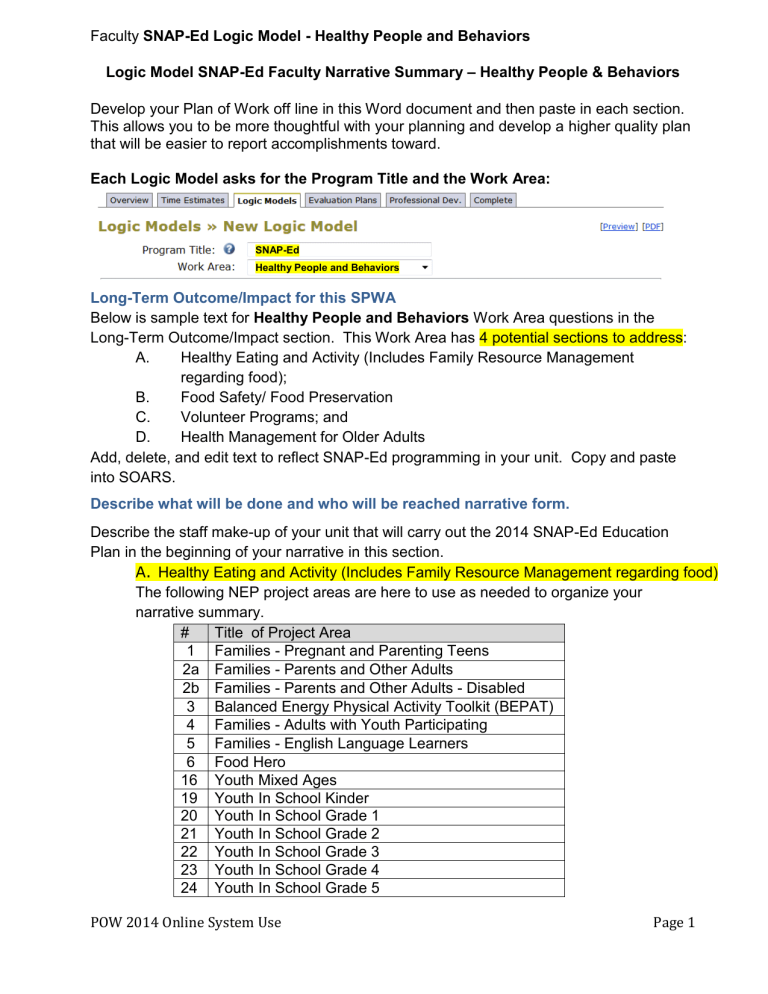
Faculty SNAP-Ed Logic Model - Healthy People and Behaviors
Logic Model SNAP-Ed Faculty Narrative Summary – Healthy People & Behaviors
Develop your Plan of Work off line in this Word document and then paste in each section.
This allows you to be more thoughtful with your planning and develop a higher quality plan that will be easier to report accomplishments toward.
Each Logic Model asks for the Program Title and the Work Area:
SNAP-Ed
Healthy People and Behaviors
Long-Term Outcome/Impact for this SPWA
Below is sample text for Healthy People and Behaviors Work Area questions in the
Long-Term Outcome/Impact section. This Work Area has 4 potential sections to address:
A. Healthy Eating and Activity (Includes Family Resource Management regarding food);
B. Food Safety/ Food Preservation
C. Volunteer Programs; and
D. Health Management for Older Adults
Add, delete, and edit text to reflect SNAP-Ed programming in your unit. Copy and paste into SOARS.
Describe what will be done and who will be reached narrative form.
Describe the staff make-up of your unit that will carry out the 2014 SNAP-Ed Education
Plan in the beginning of your narrative in this section.
A.
Healthy Eating and Activity (Includes Family Resource Management regarding food)
The following NEP project areas are here to use as needed to organize your narrative summary.
# Title of Project Area
1 Families - Pregnant and Parenting Teens
2a Families - Parents and Other Adults
2b Families - Parents and Other Adults - Disabled
3 Balanced Energy Physical Activity Toolkit (BEPAT)
4 Families - Adults with Youth Participating
5 Families - English Language Learners
6 Food Hero
16 Youth Mixed Ages
19 Youth In School Kinder
20 Youth In School Grade 1
21 Youth In School Grade 2
22 Youth In School Grade 3
23 Youth In School Grade 4
24 Youth In School Grade 5
POW 2014 Online System Use Page 1
Faculty SNAP-Ed Logic Model - Healthy People and Behaviors
# Title of Project Area
25 Youth In School Grade 6
26 Youth In School Grade 7
27 Youth In School Grade 8
28 Youth In School Grade 9
29 Youth In School Grade 10
30 Youth In School Grade 11
31 Youth In School Grade 12
Education Delivery Planned: (Copy as many of these sentences as you need to complete a summarized picture of the type and amount of education you plan to deliver for
FFY2014 in this work area. Get the data from the reformatted Online System Planned
Education Report or your own POW report).
At I will:
Deliver a series of sessions reaching parents resulting in direct education contacts. The Curricula I will use is:
Deliver series of sessions reaching family (youth and adult) participants resulting in direct education contacts. The Curricula I will use in is:
Deliver series of sessions reaching youth in school, grade resulting in
direct education contacts. The Curricula I will use in is:
Sample: At Cascade Middle School I will: Deliver a series of SNAP-Ed education sessions reaching 10 parents resulting in 80 direct education contacts. The Curricula I will use is: Eat
Smart*Be Active.
Deliver a series of SNAP-Ed education sessions reaching 30 Youth - afterschool resulting in
240 direct education contacts. The Curricula I will use is: Kids in the Kitchen.
Extended delivery by teachers: At I will: Deliver training sessions to teachers who will deliver sessions using SNAP-Ed instructional materials to youth in-school increasing the number of contacts in each classroom.
See Training Volunteers to deliver SNAP-Ed education below under C. Volunteer programs.
Use the BEPA Toolkit throughout my education delivery in the following ways:
Use Food Hero items throughout my education delivery as follows:
Sample: Use the BEPA Toolkit throughout my education delivery in the following ways: I will incorporate some physical activity into most education sessions with all audiences whenever possible.
Use Food Hero items throughout my education delivery .
I will wear the Food Hero apron when I am teaching, use the recipes, tablecloth, and the stickers. I will pass out or send the Monthly newsletter.
POW 2014 Online System Use Page 2
Faculty SNAP-Ed Logic Model - Healthy People and Behaviors
B.
Food Safety/Food Preservation
Copy the following text under this title:
Food Safety education is included in all SNAP-Ed education delivery involving food.
C.
Volunteer Programs
At the OSU Extension office, I will train Extension volunteers to deliver education at multiple events reaching individuals at food pantries and
Department of Human Services (DHS) sites.
D.
Health Management for Older Adults (Could be NEP education in the “Older
Adults (60+)” Project Area)
At I will:
Deliver a series of sessions reaching adult - seniors resulting in direct education contacts. The Curricula I will use is:
At I will:
Deliver a series of SNAP-Ed sessions in conjunction with Walk With Ease sessions reaching adult - seniors resulting in direct education contacts. The
Curricula I will use is: and Walk With Ease materials.
Sample:
At the Wildish Senior Center I will:
Deliver a single session reaching 15 adult - seniors resulting in 15 direct education contacts. The Curricula I will use is: Simply Good Eating ELL.
Briefly describe the process of how the need for this program was determined
(needs assessment).
SNAP-Ed submits a full Needs Assessment document at the time of Plan submission prepared by the campus team.
Locally, needs were determined while meeting with the following community collaboration partners resulting in direct contacts :
Sample: The need for SNAP-Ed programs in Columbia County continues to grow as more local schools qualify for the program by having more than 50% of children receiving free and reduced price meals. Clatskanie and Rainier communities have historically had the largest concentration of qualifying populations. Recently, however, more need is being realized in the community of St.
Helens. Community partnerships are being formed in an ongoing basis to meet these needs as they arise. Principals and other school administrators are interviewed each year to determine their support and interest in partnering on nutrition education efforts. Other community sites are selected based on their ability to reach the target population and the suitability of site facilities, space, and time available to assist in recruitment efforts.
POW 2014 Online System Use Page 3
Faculty SNAP-Ed Logic Model - Healthy People and Behaviors
What are the short-term (learning) outcomes for this program? (Narrative or outline form)
The adults and children who participate in a SNAP-Ed class series or Walk With
Ease (in conjunction with nutrition education) will gain knowledge of the need for increased consumption of fruits and vegetables, increasing levels of physical activity, reducing levels of sedentary behavior, and/or increasing their utilization of recommended strategies for achieving calorie balance, and increasing their utilization of recommended food resource management strategies.
What are the medium-term (action, behavior change) outcomes for this program?
(Narrative or outline)
The adults and children who participate in a SNAP-Ed class series or Walk With
Ease (in conjunction with nutrition education) will increase their consumption of fruits and vegetables, increase their levels of physical activity, reduce levels of sedentary behavior, and/or increase their utilization of recommended strategies for achieving calorie balance, and increase their utilization of recommended food resource management strategies.
Remember to create a new SNAP-Ed Logic Model for the additional PWAs:
X
If you need help with any of this process, please contact Jill Mills or Teresa Crowley
Jill.Mills@oregonstate.edu
541-737-8839 Campus office
541-870-5413 Cell phone
Teresa.Crowley@oregonstate.edu
541-737-1014
POW 2014 Online System Use Page 4
